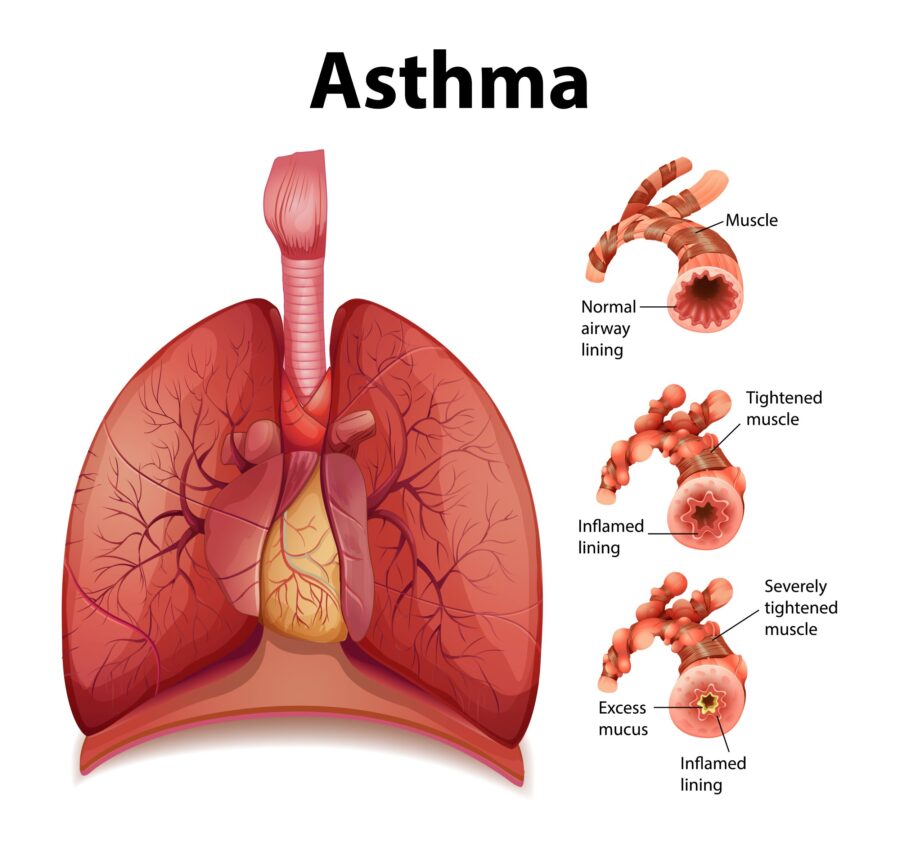“The breath of life is a gift. Every breath serves as a reminder of one’s strength and resilience, despite the difficulties associated with asthma.”

Definition:
A chronic respiratory disease, when breathing becomes difficult due to inflammation and constriction of the airways, is called as asthma. Numerous things, including allergens, respiratory illnesses, exercise, and environmental irritants, can frequently cause it. Wheezing, dyspnea, coughing, and tightness in the chest are common symptoms.
The degree of asthma episodes might differ amongst people; some may have sporadic, moderate symptoms, while others may have frequent, severe attacks. In addition to recognising and avoiding triggers, management usually entails taking drugs to reduce inflammation and alleviate symptoms.
Types:
1-Allergic:
Caused by allergens like mould, dust mites, pollen, and pet dander.
2-Non-Allergic:
Other than allergens, such as cold air, physical activity, stress, or respiratory illnesses, cause the reaction.
3-Exercise-Induced:
Feelings come on or get worse during or after physical activity.
4-Occupational:
Caused by irritants at work, including dust, fumes, gases, and chemicals.
Symptoms:
- Shortness of Breath: Breathing difficulties, particularly at night or during physical exertion.
- Wheezing: Exhaling with a high-pitched whistling sound.
- Coughing: Often worse at night or early morning, sometimes chronic.
- Chest Tightness: A pressing or uncomfortable sensation in the chest.
Diagnosis:
1-Medical History:
Signs, causes, and family history of allergies or asthma.
2-Physical Examination:
Evaluation of lung function, including sound detection for wheezing or other irregularities.
3-Lung Function Tests:
Testing lung function is a frequent way to identify and track asthma. For the diagnosis and treatment of asthma, spirometry and peak flow measurement are the two primary lung function test types.
1-Spirometry:
This exam gauges your ability to inhale and exhale, as well as how rapidly you can do so. You will breathe into a tube that is attached to a spirometer during spirometry, which measures the volume and velocity of airflow. The outcomes can aid in the diagnosis of asthma and reveal information regarding the degree of airway obstruction. Monitoring the response to therapy and evaluating lung function over time are two more uses for spirometry.
2-Peak Flow Measurement:
The process of measuring peak flow entails utilising a peak flow metre, a portable instrument that gauges your ability to exhale air quickly. It calculates the greatest speed at which you may exhale air, known as the peak expiratory flow rate, or PEFR. Peak flow monitoring can provide early warning indicators of deteriorating asthma or approaching asthma attacks by assisting in the identification of changes in lung function and asthma symptoms. It frequently serves as a guide for modifying treatment and efficiently managing asthma as part of an asthma action plan.
Treatment:
1-Medications:
- Quick-Relief Medications: Short-acting beta-agonists (e.g., albuterol) for immediate relief of symptoms.
- Long-Term Control Medications: To lower inflammation and stop symptoms, try inhaled corticosteroids, long-acting beta-agonists, leukotriene modifiers, or biologic treatments.
- Allergy Medications: Antihistamines, decongestants, or allergy shots for allergic asthma.
- Bronchodilators: Medications that relax the muscles around the airways to improve airflow.
- Biologic Therapies: Drugs with a specific focus for people with severe asthma who don’t respond to standard care.
2-Lifestyle Management:
- Identifying Triggers: Avoiding exposure to known triggers such as allergens, smoke, pollution, or cold air.
- Creating an Action Plan: A written plan developed with your healthcare provider to manage asthma attacks and adjust medications as needed.
- Regular Exercise: With proper management, many people with asthma can exercise safely.
- Quitting Smoking: Smoking can worsen symptoms and increase the risk of complications.
3-Emergency Treatment:
Rescue Inhalers, Oral Corticosteroids.
To lessen symptoms and enhance quality of life, managing asthma requires a combination of medicine, avoiding triggers, and lifestyle changes. Seeing a doctor on a regular basis is crucial for monitoring asthma control and making any treatment adjustments.
For more interesting blogs, visit: Wellnesio.com and blog page

